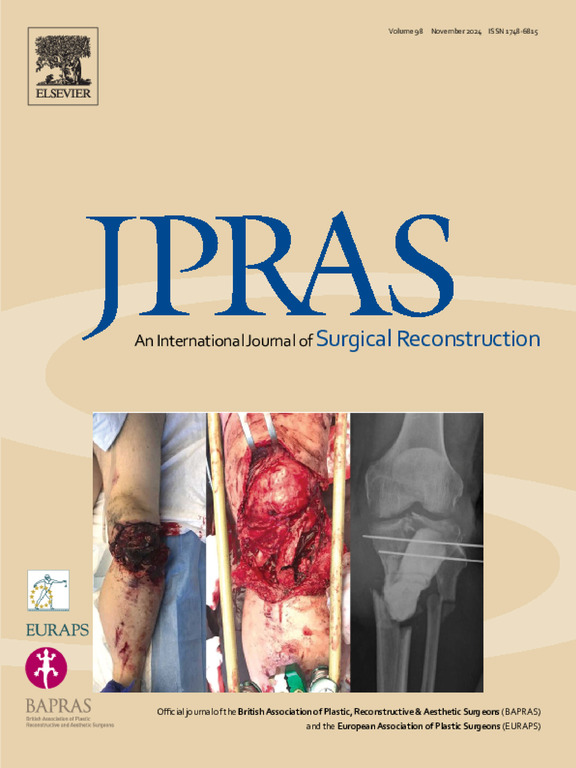基于随机森林和逻辑回归算法的胸大肌下直接植入乳房重建失败预测:一项针对中国人群的多中心研究。
IF 2
3区 医学
Q2 SURGERY
Journal of Plastic Reconstructive and Aesthetic Surgery
Pub Date : 2025-01-01
DOI:10.1016/j.bjps.2024.11.022
引用次数: 0
摘要
背景:关于直接植入(direct-to-implant, DTI)乳房重建失败的研究很少,缺乏一致的结论。因此,本研究旨在综合分析重建失败的危险因素。方法:回顾性纳入2014年7月18日至2020年1月13日期间在单中心乳房切除术后行DTI乳房重建的患者。采用随机森林和逻辑回归两种算法构建模型,分析重建失败的并发症和危险因素。随后,对两个模型进行了多中心外部验证。结果:模型构建组538例,多中心外部验证组91例,重构失败结局分别为23例和5例。随机森林分析显示,感染和创面开裂是导致重建失败的最重要因素。多因素logistic回归分析显示,体重指数(BMI)、感染、创面裂开与重建失败相关。与对照组相比,体重超重(BMI为24 kg/m2)患者失败风险高3.35%,感染患者高9.6%,创面裂开患者高42.5%。随机森林模型的内部验证受试者工作特征(ROC)值为0.990,外部验证受试者工作特征(ROC)值为0.736。logistic回归模型的内部和外部验证ROC值分别为0.995和0.826。结论:伤口开裂和感染是DTI乳房再造术失败最重要的危险因素,术前体重控制也很重要。本文章由计算机程序翻译,如有差异,请以英文原文为准。
Prediction of subpectoral direct-to-implant breast reconstruction failure based on random forest and logistic regression algorithms: A multicenter study in Chinese population
Background
Few studies have been conducted on direct-to-implant (DTI) breast reconstruction failure, and consistent conclusions are lacking. Thus, this study aimed to comprehensively analyze the risk factors of reconstruction failure.
Methods
Patients who underwent DTI breast reconstruction after mastectomy at a single center between July 18, 2014, and January 13, 2020, were retrospectively included in this study. Two algorithms, random forest and logistic regression, were employed to construct models that analyzed the complications and risk factors of reconstruction failure. Subsequently, a multicenter external validation was performed for both models.
Results
There were 538 patients in the model construction group and 91 patients in the multicenter external validation group, with 23 and 5 reconstruction failure outcomes, respectively. Random forest analysis revealed that infection and wound dehiscence were the most significant factors leading to reconstruction failure. Multivariate logistic regression analysis indicated that body mass index (BMI), infection, and wound dehiscence were correlated with reconstruction failure. The risk of failure was 3.35% higher in overweight (BMI > 24 kg/m2) patients, 9.6% higher in patients with infection, and 42.5% higher in patients with wound dehiscence than that in the control group. The internal validation receiver operating characteristic (ROC) value for the random forest model was 0.990, whereas the external validation ROC was 0.736. The internal and external validation ROC values for the logistic regression model were 0.995 and 0.826, respectively.
Conclusion
Wound dehiscence and infection were the most significant risk factors for DTI breast reconstruction failure, and preoperative weight control was also important.
求助全文
通过发布文献求助,成功后即可免费获取论文全文。
去求助
来源期刊
CiteScore
3.10
自引率
11.10%
发文量
578
审稿时长
3.5 months
期刊介绍:
JPRAS An International Journal of Surgical Reconstruction is one of the world''s leading international journals, covering all the reconstructive and aesthetic aspects of plastic surgery.
The journal presents the latest surgical procedures with audit and outcome studies of new and established techniques in plastic surgery including: cleft lip and palate and other heads and neck surgery, hand surgery, lower limb trauma, burns, skin cancer, breast surgery and aesthetic surgery.

 求助内容:
求助内容: 应助结果提醒方式:
应助结果提醒方式:


